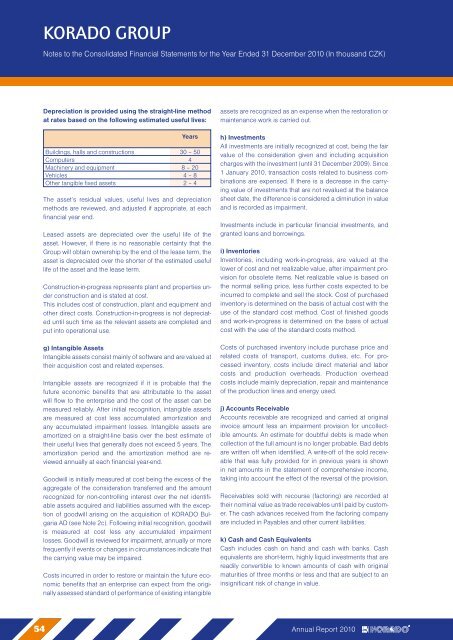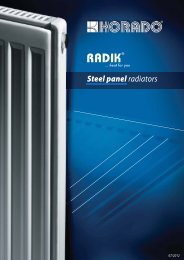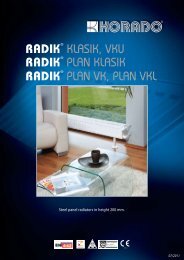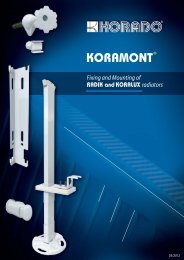ANNUAL REPORT - KORADO, as
ANNUAL REPORT - KORADO, as
ANNUAL REPORT - KORADO, as
Create successful ePaper yourself
Turn your PDF publications into a flip-book with our unique Google optimized e-Paper software.
54<br />
<strong>KORADO</strong> GROUP<br />
Notes to the Consolidated Financial Statements for the Year Ended 31 December 2010 (In thousand CZK)<br />
Depreciation is provided using the straight-line method<br />
at rates b<strong>as</strong>ed on the following estimated useful lives:<br />
Years<br />
Buildings, halls and constructions 30 – 50<br />
Computers 4<br />
Machinery and equipment 8 – 20<br />
Vehicles 4 – 8<br />
Other tangible fixed <strong>as</strong>sets 2 – 4<br />
The <strong>as</strong>set’s residual values, useful lives and depreciation<br />
methods are reviewed, and adjusted if appropriate, at each<br />
financial year end.<br />
Le<strong>as</strong>ed <strong>as</strong>sets are depreciated over the useful life of the<br />
<strong>as</strong>set. However, if there is no re<strong>as</strong>onable certainty that the<br />
Group will obtain ownership by the end of the le<strong>as</strong>e term, the<br />
<strong>as</strong>set is depreciated over the shorter of the estimated useful<br />
life of the <strong>as</strong>set and the le<strong>as</strong>e term.<br />
Construction-in-progress represents plant and properties under<br />
construction and is stated at cost.<br />
This includes cost of construction, plant and equipment and<br />
other direct costs. Construction-in-progress is not depreciated<br />
until such time <strong>as</strong> the relevant <strong>as</strong>sets are completed and<br />
put into operational use.<br />
g) Intangible Assets<br />
Intangible <strong>as</strong>sets consist mainly of software and are valued at<br />
their acquisition cost and related expenses.<br />
Intangible <strong>as</strong>sets are recognized if it is probable that the<br />
future economic benefits that are attributable to the <strong>as</strong>set<br />
will flow to the enterprise and the cost of the <strong>as</strong>set can be<br />
me<strong>as</strong>ured reliably. After initial recognition, intangible <strong>as</strong>sets<br />
are me<strong>as</strong>ured at cost less accumulated amortization and<br />
any accumulated impairment losses. Intangible <strong>as</strong>sets are<br />
amortized on a straight-line b<strong>as</strong>is over the best estimate of<br />
their useful lives that generally does not exceed 5 years. The<br />
amortization period and the amortization method are reviewed<br />
annually at each financial year-end.<br />
Goodwill is initially me<strong>as</strong>ured at cost being the excess of the<br />
aggregate of the consideration transferred and the amount<br />
recognized for non-controlling interest over the net identifiable<br />
<strong>as</strong>sets acquired and liabilities <strong>as</strong>sumed with the exception<br />
of goodwill arising on the acquisition of <strong>KORADO</strong> Bulgaria<br />
AD (see Note 2c). Following initial recognition, goodwill<br />
is me<strong>as</strong>ured at cost less any accumulated impairment<br />
losses. Goodwill is reviewed for impairment, annually or more<br />
frequently if events or changes in circumstances indicate that<br />
the carrying value may be impaired.<br />
Costs incurred in order to restore or maintain the future economic<br />
benefits that an enterprise can expect from the originally<br />
<strong>as</strong>sessed standard of performance of existing intangible<br />
<strong>as</strong>sets are recognized <strong>as</strong> an expense when the restoration or<br />
maintenance work is carried out.<br />
h) Investments<br />
All investments are initially recognized at cost, being the fair<br />
value of the consideration given and including acquisition<br />
charges with the investment (until 31 December 2009). Since<br />
1 January 2010, transaction costs related to business combinations<br />
are expensed. If there is a decre<strong>as</strong>e in the carrying<br />
value of investments that are not revalued at the balance<br />
sheet date, the difference is considered a diminution in value<br />
and is recorded <strong>as</strong> impairment.<br />
Investments include in particular financial investments, and<br />
granted loans and borrowings.<br />
i) Inventories<br />
Inventories, including work-in-progress, are valued at the<br />
lower of cost and net realizable value, after impairment provision<br />
for obsolete items. Net realizable value is b<strong>as</strong>ed on<br />
the normal selling price, less further costs expected to be<br />
incurred to complete and sell the stock. Cost of purch<strong>as</strong>ed<br />
inventory is determined on the b<strong>as</strong>is of actual cost with the<br />
use of the standard cost method. Cost of finished goods<br />
and work-in-progress is determined on the b<strong>as</strong>is of actual<br />
cost with the use of the standard costs method.<br />
Costs of purch<strong>as</strong>ed inventory include purch<strong>as</strong>e price and<br />
related costs of transport, customs duties, etc. For processed<br />
inventory, costs include direct material and labor<br />
costs and production overheads. Production overhead<br />
costs include mainly depreciation, repair and maintenance<br />
of the production lines and energy used.<br />
j) Accounts Receivable<br />
Accounts receivable are recognized and carried at original<br />
invoice amount less an impairment provision for uncollectible<br />
amounts. An estimate for doubtful debts is made when<br />
collection of the full amount is no longer probable. Bad debts<br />
are written off when identified. A write-off of the sold receivable<br />
that w<strong>as</strong> fully provided for in previous years is shown<br />
in net amounts in the statement of comprehensive income,<br />
taking into account the effect of the reversal of the provision.<br />
Receivables sold with recourse (factoring) are recorded at<br />
their nominal value <strong>as</strong> trade receivables until paid by customer.<br />
The c<strong>as</strong>h advances received from the factoring company<br />
are included in Payables and other current liabilities.<br />
k) C<strong>as</strong>h and C<strong>as</strong>h Equivalents<br />
C<strong>as</strong>h includes c<strong>as</strong>h on hand and c<strong>as</strong>h with banks. C<strong>as</strong>h<br />
equivalents are short-term, highly liquid investments that are<br />
readily convertible to known amounts of c<strong>as</strong>h with original<br />
maturities of three months or less and that are subject to an<br />
insignificant risk of change in value.<br />
Annual Report 2010





